Auditing Theory and Practice: Detailed Account Analysis Report
VerifiedAdded on 2020/04/01
|10
|1655
|466
Report
AI Summary
This report delves into auditing theory and practice, focusing on audit planning and the analysis of various accounts. The report begins with an overview of audit planning, analytical review, and materiality. It then examines specific accounts from a trial balance, including accumulated depreciation on machinery, cost of sales, inventory, consultancy fees, wages, superannuation, and accounts receivable. For each account, the report provides a rationale for selection, relevant assertions, and recommended audit procedures. The analysis covers key aspects like depreciation rates, cost of sales percentages, inventory valuation, and expense variations. The report aims to provide a comprehensive understanding of the auditing process and the importance of analyzing financial statements for potential misstatements or errors. The report references several academic sources to support its findings, and it provides a practical application of auditing principles to real-world financial data. This assignment is contributed by a student to be published on the website Desklib, a platform which provides all the necessary AI based study tools for students.
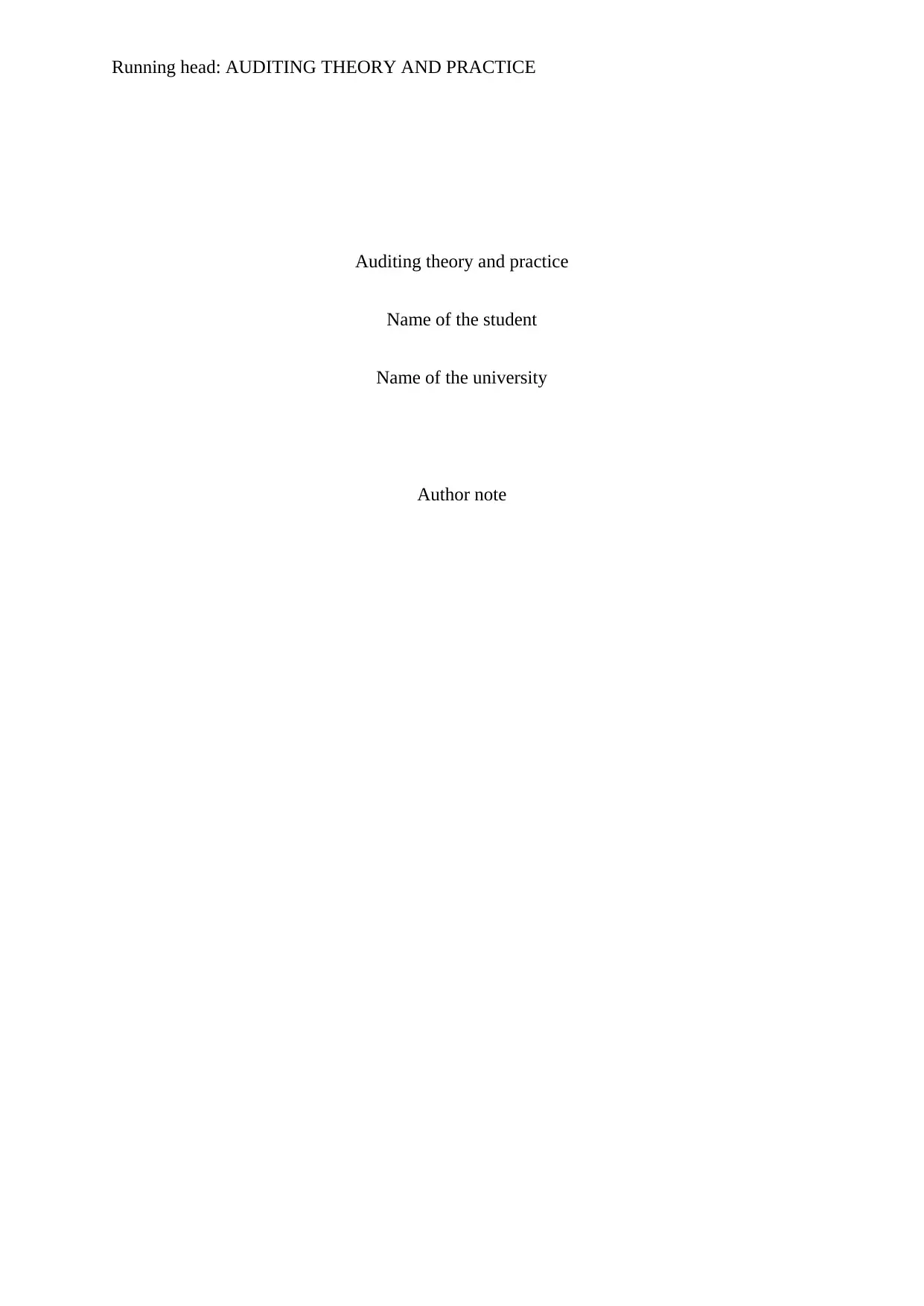
Running head: AUDITING THEORY AND PRACTICE
Auditing theory and practice
Name of the student
Name of the university
Author note
Auditing theory and practice
Name of the student
Name of the university
Author note
Paraphrase This Document
Need a fresh take? Get an instant paraphrase of this document with our AI Paraphraser
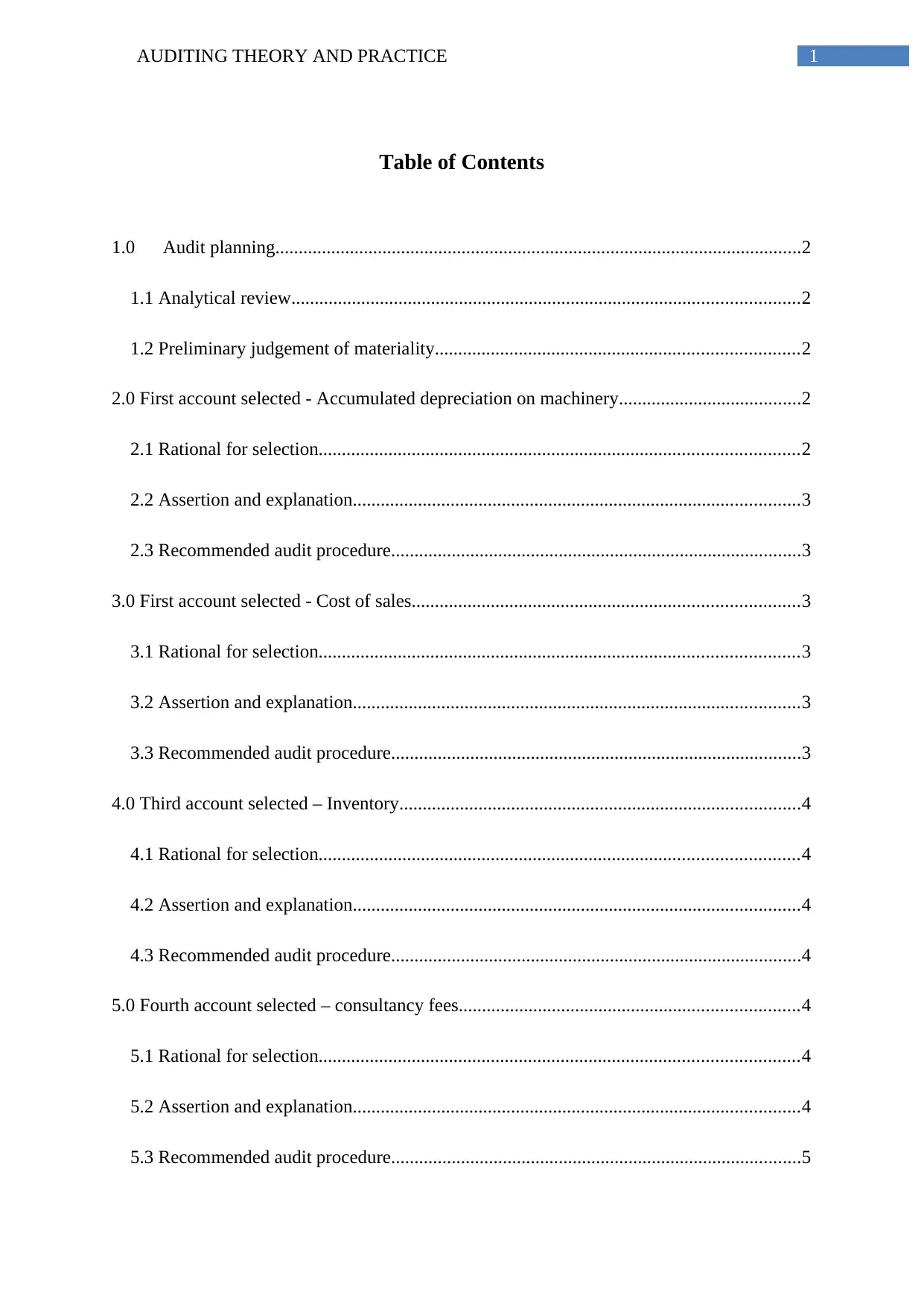
1AUDITING THEORY AND PRACTICE
Table of Contents
1.0 Audit planning.................................................................................................................2
1.1 Analytical review.............................................................................................................2
1.2 Preliminary judgement of materiality..............................................................................2
2.0 First account selected - Accumulated depreciation on machinery.......................................2
2.1 Rational for selection.......................................................................................................2
2.2 Assertion and explanation................................................................................................3
2.3 Recommended audit procedure........................................................................................3
3.0 First account selected - Cost of sales...................................................................................3
3.1 Rational for selection.......................................................................................................3
3.2 Assertion and explanation................................................................................................3
3.3 Recommended audit procedure........................................................................................3
4.0 Third account selected – Inventory......................................................................................4
4.1 Rational for selection.......................................................................................................4
4.2 Assertion and explanation................................................................................................4
4.3 Recommended audit procedure........................................................................................4
5.0 Fourth account selected – consultancy fees.........................................................................4
5.1 Rational for selection.......................................................................................................4
5.2 Assertion and explanation................................................................................................4
5.3 Recommended audit procedure........................................................................................5
Table of Contents
1.0 Audit planning.................................................................................................................2
1.1 Analytical review.............................................................................................................2
1.2 Preliminary judgement of materiality..............................................................................2
2.0 First account selected - Accumulated depreciation on machinery.......................................2
2.1 Rational for selection.......................................................................................................2
2.2 Assertion and explanation................................................................................................3
2.3 Recommended audit procedure........................................................................................3
3.0 First account selected - Cost of sales...................................................................................3
3.1 Rational for selection.......................................................................................................3
3.2 Assertion and explanation................................................................................................3
3.3 Recommended audit procedure........................................................................................3
4.0 Third account selected – Inventory......................................................................................4
4.1 Rational for selection.......................................................................................................4
4.2 Assertion and explanation................................................................................................4
4.3 Recommended audit procedure........................................................................................4
5.0 Fourth account selected – consultancy fees.........................................................................4
5.1 Rational for selection.......................................................................................................4
5.2 Assertion and explanation................................................................................................4
5.3 Recommended audit procedure........................................................................................5
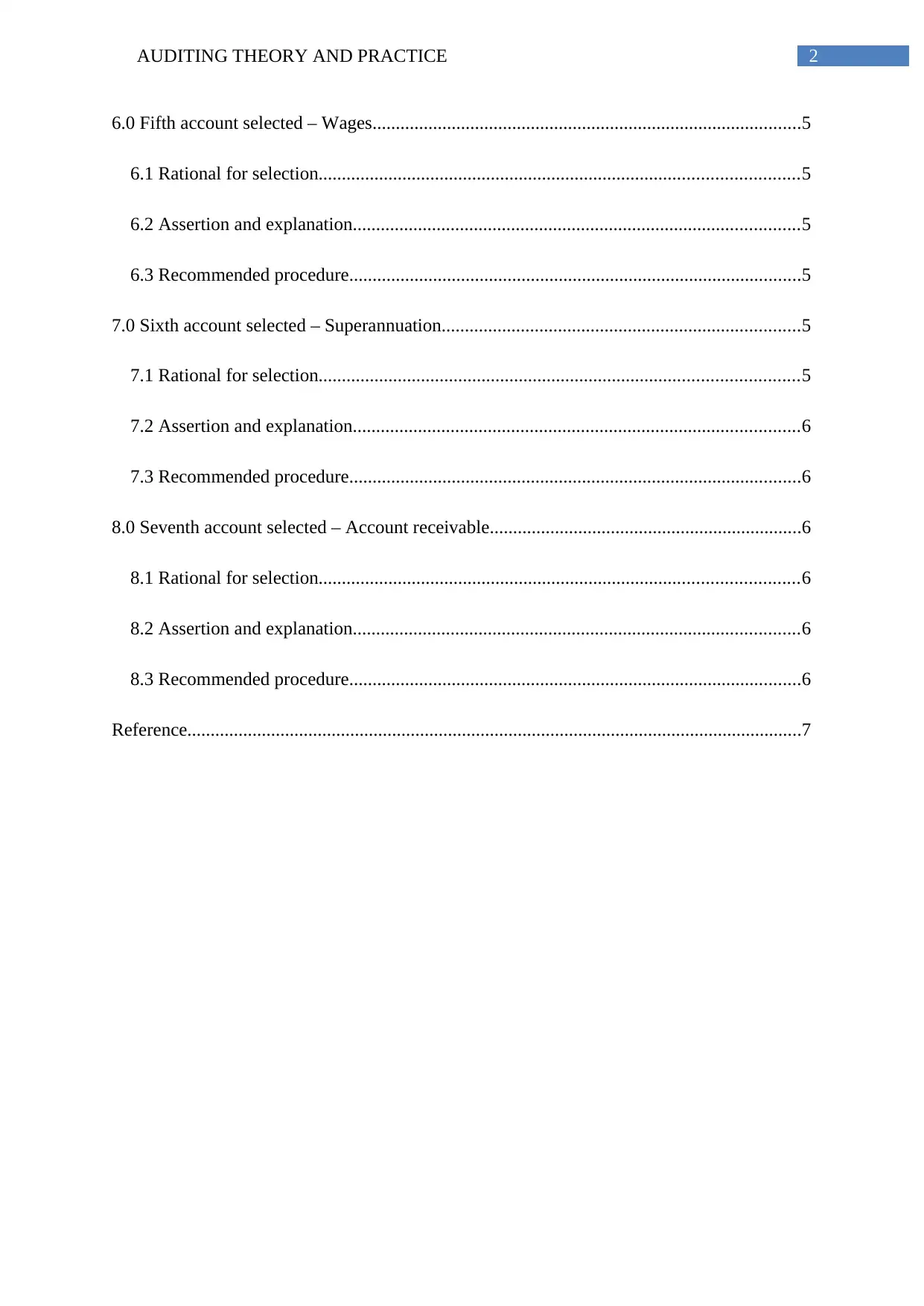
2AUDITING THEORY AND PRACTICE
6.0 Fifth account selected – Wages............................................................................................5
6.1 Rational for selection.......................................................................................................5
6.2 Assertion and explanation................................................................................................5
6.3 Recommended procedure.................................................................................................5
7.0 Sixth account selected – Superannuation.............................................................................5
7.1 Rational for selection.......................................................................................................5
7.2 Assertion and explanation................................................................................................6
7.3 Recommended procedure.................................................................................................6
8.0 Seventh account selected – Account receivable...................................................................6
8.1 Rational for selection.......................................................................................................6
8.2 Assertion and explanation................................................................................................6
8.3 Recommended procedure.................................................................................................6
Reference....................................................................................................................................7
6.0 Fifth account selected – Wages............................................................................................5
6.1 Rational for selection.......................................................................................................5
6.2 Assertion and explanation................................................................................................5
6.3 Recommended procedure.................................................................................................5
7.0 Sixth account selected – Superannuation.............................................................................5
7.1 Rational for selection.......................................................................................................5
7.2 Assertion and explanation................................................................................................6
7.3 Recommended procedure.................................................................................................6
8.0 Seventh account selected – Account receivable...................................................................6
8.1 Rational for selection.......................................................................................................6
8.2 Assertion and explanation................................................................................................6
8.3 Recommended procedure.................................................................................................6
Reference....................................................................................................................................7
⊘ This is a preview!⊘
Do you want full access?
Subscribe today to unlock all pages.

Trusted by 1+ million students worldwide
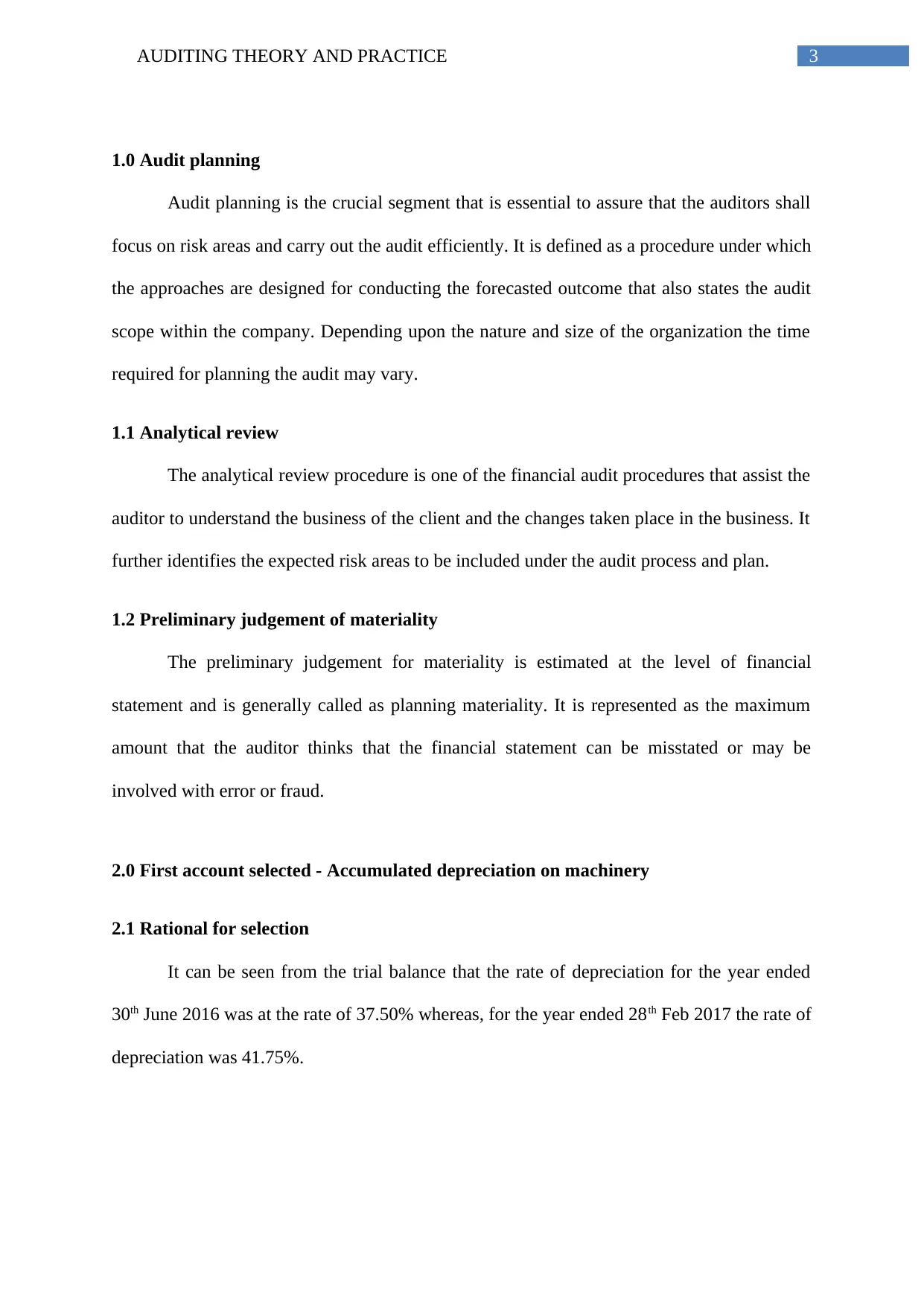
3AUDITING THEORY AND PRACTICE
1.0 Audit planning
Audit planning is the crucial segment that is essential to assure that the auditors shall
focus on risk areas and carry out the audit efficiently. It is defined as a procedure under which
the approaches are designed for conducting the forecasted outcome that also states the audit
scope within the company. Depending upon the nature and size of the organization the time
required for planning the audit may vary.
1.1 Analytical review
The analytical review procedure is one of the financial audit procedures that assist the
auditor to understand the business of the client and the changes taken place in the business. It
further identifies the expected risk areas to be included under the audit process and plan.
1.2 Preliminary judgement of materiality
The preliminary judgement for materiality is estimated at the level of financial
statement and is generally called as planning materiality. It is represented as the maximum
amount that the auditor thinks that the financial statement can be misstated or may be
involved with error or fraud.
2.0 First account selected - Accumulated depreciation on machinery
2.1 Rational for selection
It can be seen from the trial balance that the rate of depreciation for the year ended
30th June 2016 was at the rate of 37.50% whereas, for the year ended 28th Feb 2017 the rate of
depreciation was 41.75%.
1.0 Audit planning
Audit planning is the crucial segment that is essential to assure that the auditors shall
focus on risk areas and carry out the audit efficiently. It is defined as a procedure under which
the approaches are designed for conducting the forecasted outcome that also states the audit
scope within the company. Depending upon the nature and size of the organization the time
required for planning the audit may vary.
1.1 Analytical review
The analytical review procedure is one of the financial audit procedures that assist the
auditor to understand the business of the client and the changes taken place in the business. It
further identifies the expected risk areas to be included under the audit process and plan.
1.2 Preliminary judgement of materiality
The preliminary judgement for materiality is estimated at the level of financial
statement and is generally called as planning materiality. It is represented as the maximum
amount that the auditor thinks that the financial statement can be misstated or may be
involved with error or fraud.
2.0 First account selected - Accumulated depreciation on machinery
2.1 Rational for selection
It can be seen from the trial balance that the rate of depreciation for the year ended
30th June 2016 was at the rate of 37.50% whereas, for the year ended 28th Feb 2017 the rate of
depreciation was 41.75%.
Paraphrase This Document
Need a fresh take? Get an instant paraphrase of this document with our AI Paraphraser
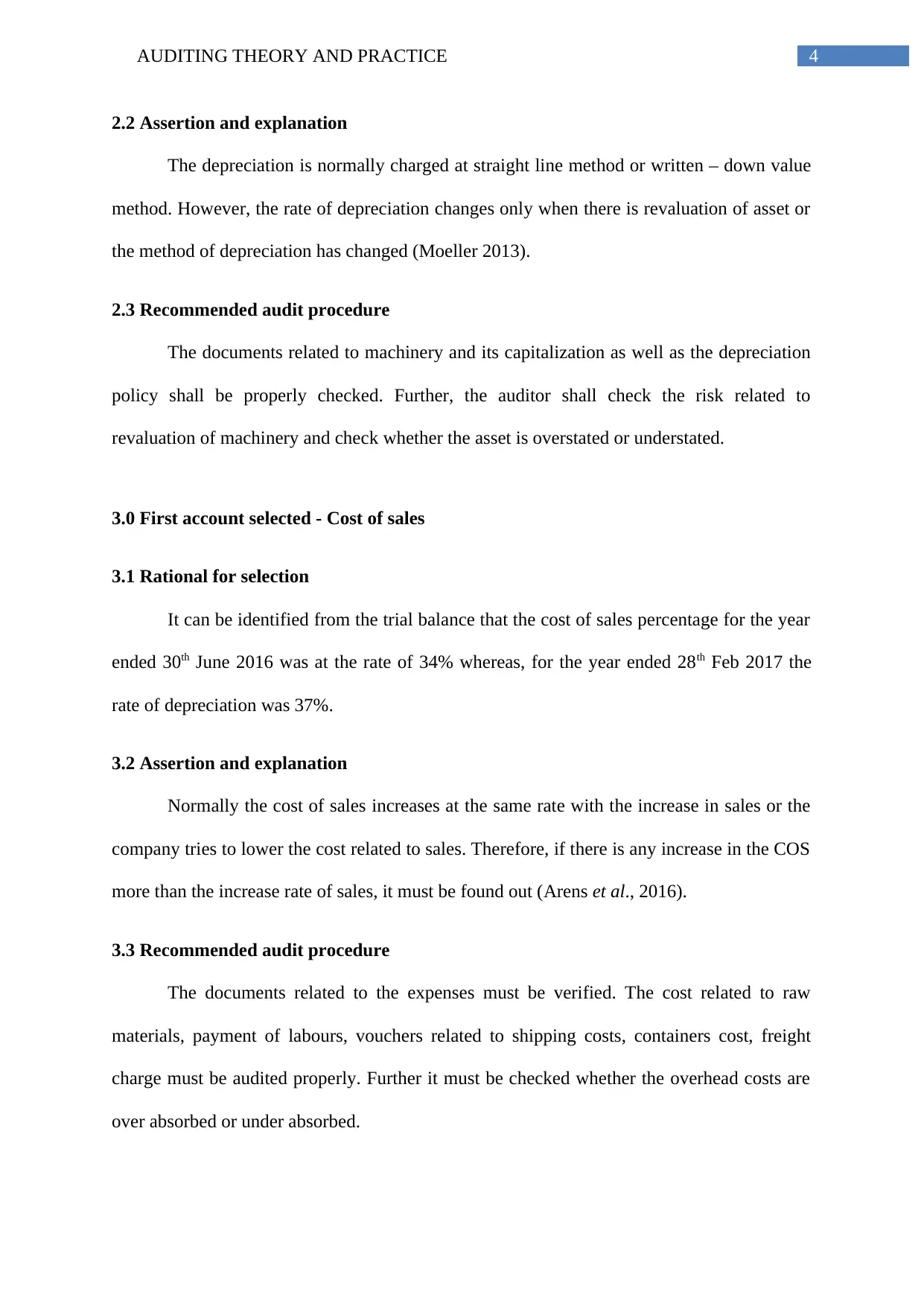
4AUDITING THEORY AND PRACTICE
2.2 Assertion and explanation
The depreciation is normally charged at straight line method or written – down value
method. However, the rate of depreciation changes only when there is revaluation of asset or
the method of depreciation has changed (Moeller 2013).
2.3 Recommended audit procedure
The documents related to machinery and its capitalization as well as the depreciation
policy shall be properly checked. Further, the auditor shall check the risk related to
revaluation of machinery and check whether the asset is overstated or understated.
3.0 First account selected - Cost of sales
3.1 Rational for selection
It can be identified from the trial balance that the cost of sales percentage for the year
ended 30th June 2016 was at the rate of 34% whereas, for the year ended 28th Feb 2017 the
rate of depreciation was 37%.
3.2 Assertion and explanation
Normally the cost of sales increases at the same rate with the increase in sales or the
company tries to lower the cost related to sales. Therefore, if there is any increase in the COS
more than the increase rate of sales, it must be found out (Arens et al., 2016).
3.3 Recommended audit procedure
The documents related to the expenses must be verified. The cost related to raw
materials, payment of labours, vouchers related to shipping costs, containers cost, freight
charge must be audited properly. Further it must be checked whether the overhead costs are
over absorbed or under absorbed.
2.2 Assertion and explanation
The depreciation is normally charged at straight line method or written – down value
method. However, the rate of depreciation changes only when there is revaluation of asset or
the method of depreciation has changed (Moeller 2013).
2.3 Recommended audit procedure
The documents related to machinery and its capitalization as well as the depreciation
policy shall be properly checked. Further, the auditor shall check the risk related to
revaluation of machinery and check whether the asset is overstated or understated.
3.0 First account selected - Cost of sales
3.1 Rational for selection
It can be identified from the trial balance that the cost of sales percentage for the year
ended 30th June 2016 was at the rate of 34% whereas, for the year ended 28th Feb 2017 the
rate of depreciation was 37%.
3.2 Assertion and explanation
Normally the cost of sales increases at the same rate with the increase in sales or the
company tries to lower the cost related to sales. Therefore, if there is any increase in the COS
more than the increase rate of sales, it must be found out (Arens et al., 2016).
3.3 Recommended audit procedure
The documents related to the expenses must be verified. The cost related to raw
materials, payment of labours, vouchers related to shipping costs, containers cost, freight
charge must be audited properly. Further it must be checked whether the overhead costs are
over absorbed or under absorbed.
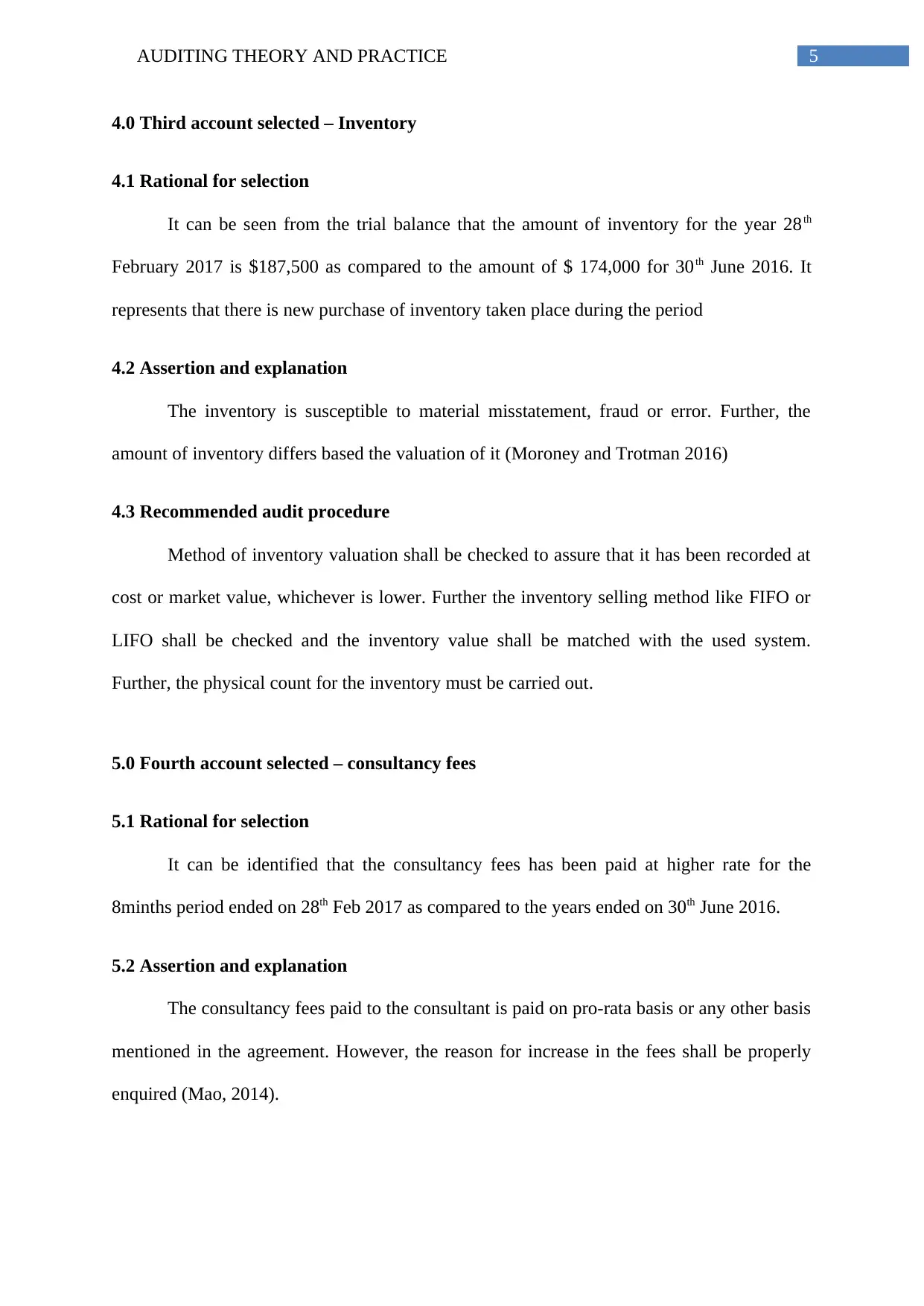
5AUDITING THEORY AND PRACTICE
4.0 Third account selected – Inventory
4.1 Rational for selection
It can be seen from the trial balance that the amount of inventory for the year 28th
February 2017 is $187,500 as compared to the amount of $ 174,000 for 30th June 2016. It
represents that there is new purchase of inventory taken place during the period
4.2 Assertion and explanation
The inventory is susceptible to material misstatement, fraud or error. Further, the
amount of inventory differs based the valuation of it (Moroney and Trotman 2016)
4.3 Recommended audit procedure
Method of inventory valuation shall be checked to assure that it has been recorded at
cost or market value, whichever is lower. Further the inventory selling method like FIFO or
LIFO shall be checked and the inventory value shall be matched with the used system.
Further, the physical count for the inventory must be carried out.
5.0 Fourth account selected – consultancy fees
5.1 Rational for selection
It can be identified that the consultancy fees has been paid at higher rate for the
8minths period ended on 28th Feb 2017 as compared to the years ended on 30th June 2016.
5.2 Assertion and explanation
The consultancy fees paid to the consultant is paid on pro-rata basis or any other basis
mentioned in the agreement. However, the reason for increase in the fees shall be properly
enquired (Mao, 2014).
4.0 Third account selected – Inventory
4.1 Rational for selection
It can be seen from the trial balance that the amount of inventory for the year 28th
February 2017 is $187,500 as compared to the amount of $ 174,000 for 30th June 2016. It
represents that there is new purchase of inventory taken place during the period
4.2 Assertion and explanation
The inventory is susceptible to material misstatement, fraud or error. Further, the
amount of inventory differs based the valuation of it (Moroney and Trotman 2016)
4.3 Recommended audit procedure
Method of inventory valuation shall be checked to assure that it has been recorded at
cost or market value, whichever is lower. Further the inventory selling method like FIFO or
LIFO shall be checked and the inventory value shall be matched with the used system.
Further, the physical count for the inventory must be carried out.
5.0 Fourth account selected – consultancy fees
5.1 Rational for selection
It can be identified that the consultancy fees has been paid at higher rate for the
8minths period ended on 28th Feb 2017 as compared to the years ended on 30th June 2016.
5.2 Assertion and explanation
The consultancy fees paid to the consultant is paid on pro-rata basis or any other basis
mentioned in the agreement. However, the reason for increase in the fees shall be properly
enquired (Mao, 2014).
⊘ This is a preview!⊘
Do you want full access?
Subscribe today to unlock all pages.

Trusted by 1+ million students worldwide
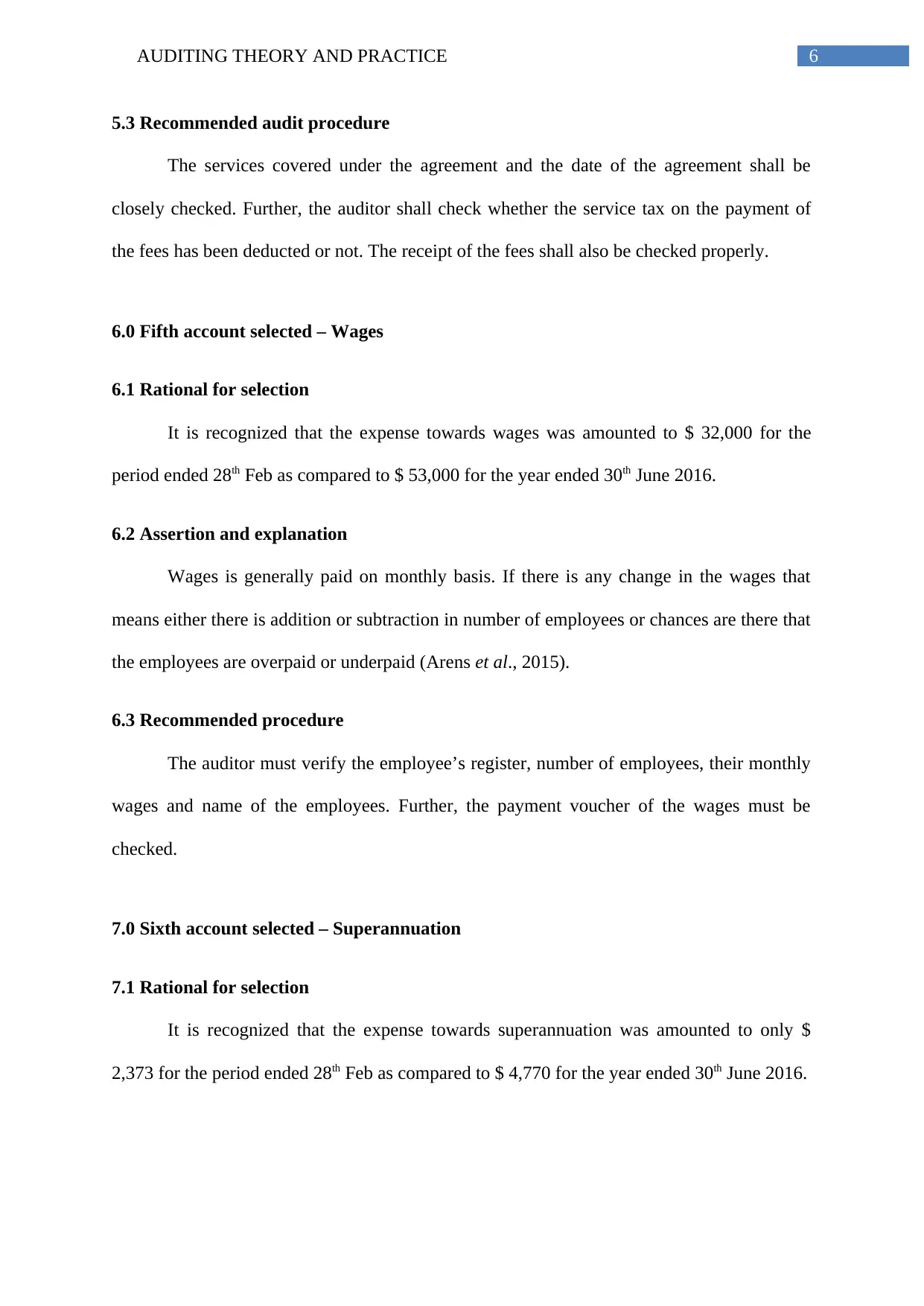
6AUDITING THEORY AND PRACTICE
5.3 Recommended audit procedure
The services covered under the agreement and the date of the agreement shall be
closely checked. Further, the auditor shall check whether the service tax on the payment of
the fees has been deducted or not. The receipt of the fees shall also be checked properly.
6.0 Fifth account selected – Wages
6.1 Rational for selection
It is recognized that the expense towards wages was amounted to $ 32,000 for the
period ended 28th Feb as compared to $ 53,000 for the year ended 30th June 2016.
6.2 Assertion and explanation
Wages is generally paid on monthly basis. If there is any change in the wages that
means either there is addition or subtraction in number of employees or chances are there that
the employees are overpaid or underpaid (Arens et al., 2015).
6.3 Recommended procedure
The auditor must verify the employee’s register, number of employees, their monthly
wages and name of the employees. Further, the payment voucher of the wages must be
checked.
7.0 Sixth account selected – Superannuation
7.1 Rational for selection
It is recognized that the expense towards superannuation was amounted to only $
2,373 for the period ended 28th Feb as compared to $ 4,770 for the year ended 30th June 2016.
5.3 Recommended audit procedure
The services covered under the agreement and the date of the agreement shall be
closely checked. Further, the auditor shall check whether the service tax on the payment of
the fees has been deducted or not. The receipt of the fees shall also be checked properly.
6.0 Fifth account selected – Wages
6.1 Rational for selection
It is recognized that the expense towards wages was amounted to $ 32,000 for the
period ended 28th Feb as compared to $ 53,000 for the year ended 30th June 2016.
6.2 Assertion and explanation
Wages is generally paid on monthly basis. If there is any change in the wages that
means either there is addition or subtraction in number of employees or chances are there that
the employees are overpaid or underpaid (Arens et al., 2015).
6.3 Recommended procedure
The auditor must verify the employee’s register, number of employees, their monthly
wages and name of the employees. Further, the payment voucher of the wages must be
checked.
7.0 Sixth account selected – Superannuation
7.1 Rational for selection
It is recognized that the expense towards superannuation was amounted to only $
2,373 for the period ended 28th Feb as compared to $ 4,770 for the year ended 30th June 2016.
Paraphrase This Document
Need a fresh take? Get an instant paraphrase of this document with our AI Paraphraser
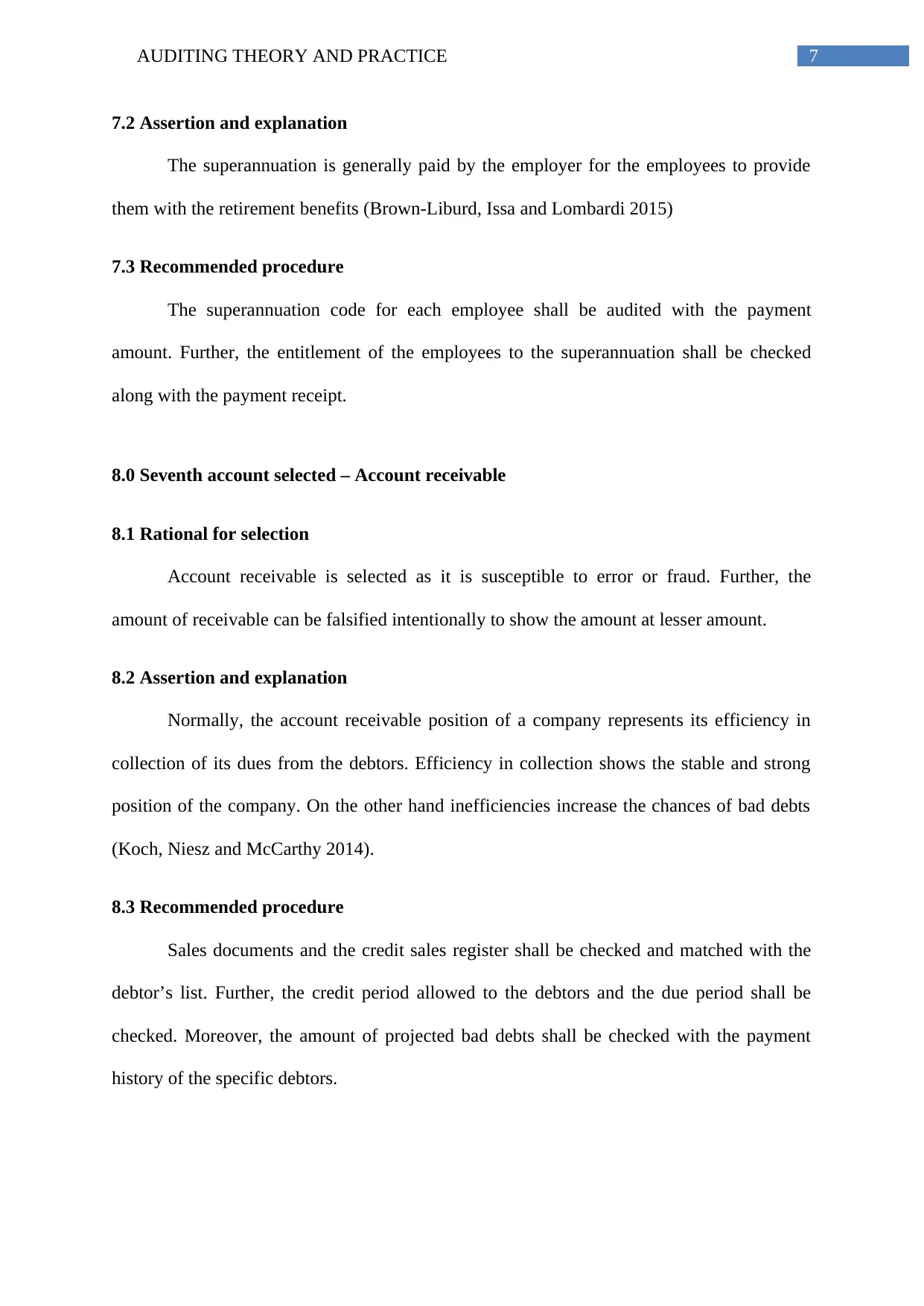
7AUDITING THEORY AND PRACTICE
7.2 Assertion and explanation
The superannuation is generally paid by the employer for the employees to provide
them with the retirement benefits (Brown-Liburd, Issa and Lombardi 2015)
7.3 Recommended procedure
The superannuation code for each employee shall be audited with the payment
amount. Further, the entitlement of the employees to the superannuation shall be checked
along with the payment receipt.
8.0 Seventh account selected – Account receivable
8.1 Rational for selection
Account receivable is selected as it is susceptible to error or fraud. Further, the
amount of receivable can be falsified intentionally to show the amount at lesser amount.
8.2 Assertion and explanation
Normally, the account receivable position of a company represents its efficiency in
collection of its dues from the debtors. Efficiency in collection shows the stable and strong
position of the company. On the other hand inefficiencies increase the chances of bad debts
(Koch, Niesz and McCarthy 2014).
8.3 Recommended procedure
Sales documents and the credit sales register shall be checked and matched with the
debtor’s list. Further, the credit period allowed to the debtors and the due period shall be
checked. Moreover, the amount of projected bad debts shall be checked with the payment
history of the specific debtors.
7.2 Assertion and explanation
The superannuation is generally paid by the employer for the employees to provide
them with the retirement benefits (Brown-Liburd, Issa and Lombardi 2015)
7.3 Recommended procedure
The superannuation code for each employee shall be audited with the payment
amount. Further, the entitlement of the employees to the superannuation shall be checked
along with the payment receipt.
8.0 Seventh account selected – Account receivable
8.1 Rational for selection
Account receivable is selected as it is susceptible to error or fraud. Further, the
amount of receivable can be falsified intentionally to show the amount at lesser amount.
8.2 Assertion and explanation
Normally, the account receivable position of a company represents its efficiency in
collection of its dues from the debtors. Efficiency in collection shows the stable and strong
position of the company. On the other hand inefficiencies increase the chances of bad debts
(Koch, Niesz and McCarthy 2014).
8.3 Recommended procedure
Sales documents and the credit sales register shall be checked and matched with the
debtor’s list. Further, the credit period allowed to the debtors and the due period shall be
checked. Moreover, the amount of projected bad debts shall be checked with the payment
history of the specific debtors.
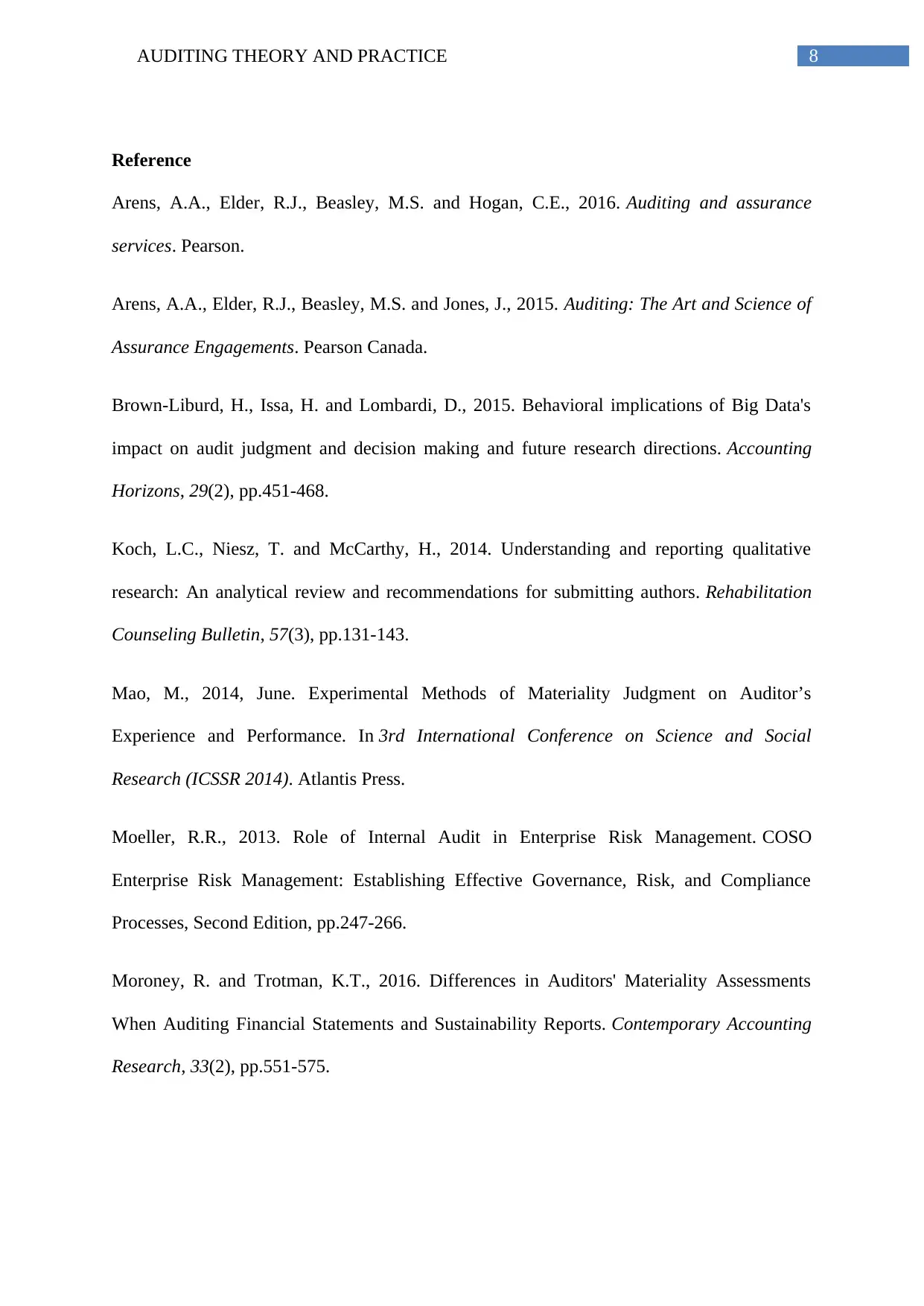
8AUDITING THEORY AND PRACTICE
Reference
Arens, A.A., Elder, R.J., Beasley, M.S. and Hogan, C.E., 2016. Auditing and assurance
services. Pearson.
Arens, A.A., Elder, R.J., Beasley, M.S. and Jones, J., 2015. Auditing: The Art and Science of
Assurance Engagements. Pearson Canada.
Brown-Liburd, H., Issa, H. and Lombardi, D., 2015. Behavioral implications of Big Data's
impact on audit judgment and decision making and future research directions. Accounting
Horizons, 29(2), pp.451-468.
Koch, L.C., Niesz, T. and McCarthy, H., 2014. Understanding and reporting qualitative
research: An analytical review and recommendations for submitting authors. Rehabilitation
Counseling Bulletin, 57(3), pp.131-143.
Mao, M., 2014, June. Experimental Methods of Materiality Judgment on Auditor’s
Experience and Performance. In 3rd International Conference on Science and Social
Research (ICSSR 2014). Atlantis Press.
Moeller, R.R., 2013. Role of Internal Audit in Enterprise Risk Management. COSO
Enterprise Risk Management: Establishing Effective Governance, Risk, and Compliance
Processes, Second Edition, pp.247-266.
Moroney, R. and Trotman, K.T., 2016. Differences in Auditors' Materiality Assessments
When Auditing Financial Statements and Sustainability Reports. Contemporary Accounting
Research, 33(2), pp.551-575.
Reference
Arens, A.A., Elder, R.J., Beasley, M.S. and Hogan, C.E., 2016. Auditing and assurance
services. Pearson.
Arens, A.A., Elder, R.J., Beasley, M.S. and Jones, J., 2015. Auditing: The Art and Science of
Assurance Engagements. Pearson Canada.
Brown-Liburd, H., Issa, H. and Lombardi, D., 2015. Behavioral implications of Big Data's
impact on audit judgment and decision making and future research directions. Accounting
Horizons, 29(2), pp.451-468.
Koch, L.C., Niesz, T. and McCarthy, H., 2014. Understanding and reporting qualitative
research: An analytical review and recommendations for submitting authors. Rehabilitation
Counseling Bulletin, 57(3), pp.131-143.
Mao, M., 2014, June. Experimental Methods of Materiality Judgment on Auditor’s
Experience and Performance. In 3rd International Conference on Science and Social
Research (ICSSR 2014). Atlantis Press.
Moeller, R.R., 2013. Role of Internal Audit in Enterprise Risk Management. COSO
Enterprise Risk Management: Establishing Effective Governance, Risk, and Compliance
Processes, Second Edition, pp.247-266.
Moroney, R. and Trotman, K.T., 2016. Differences in Auditors' Materiality Assessments
When Auditing Financial Statements and Sustainability Reports. Contemporary Accounting
Research, 33(2), pp.551-575.
⊘ This is a preview!⊘
Do you want full access?
Subscribe today to unlock all pages.

Trusted by 1+ million students worldwide
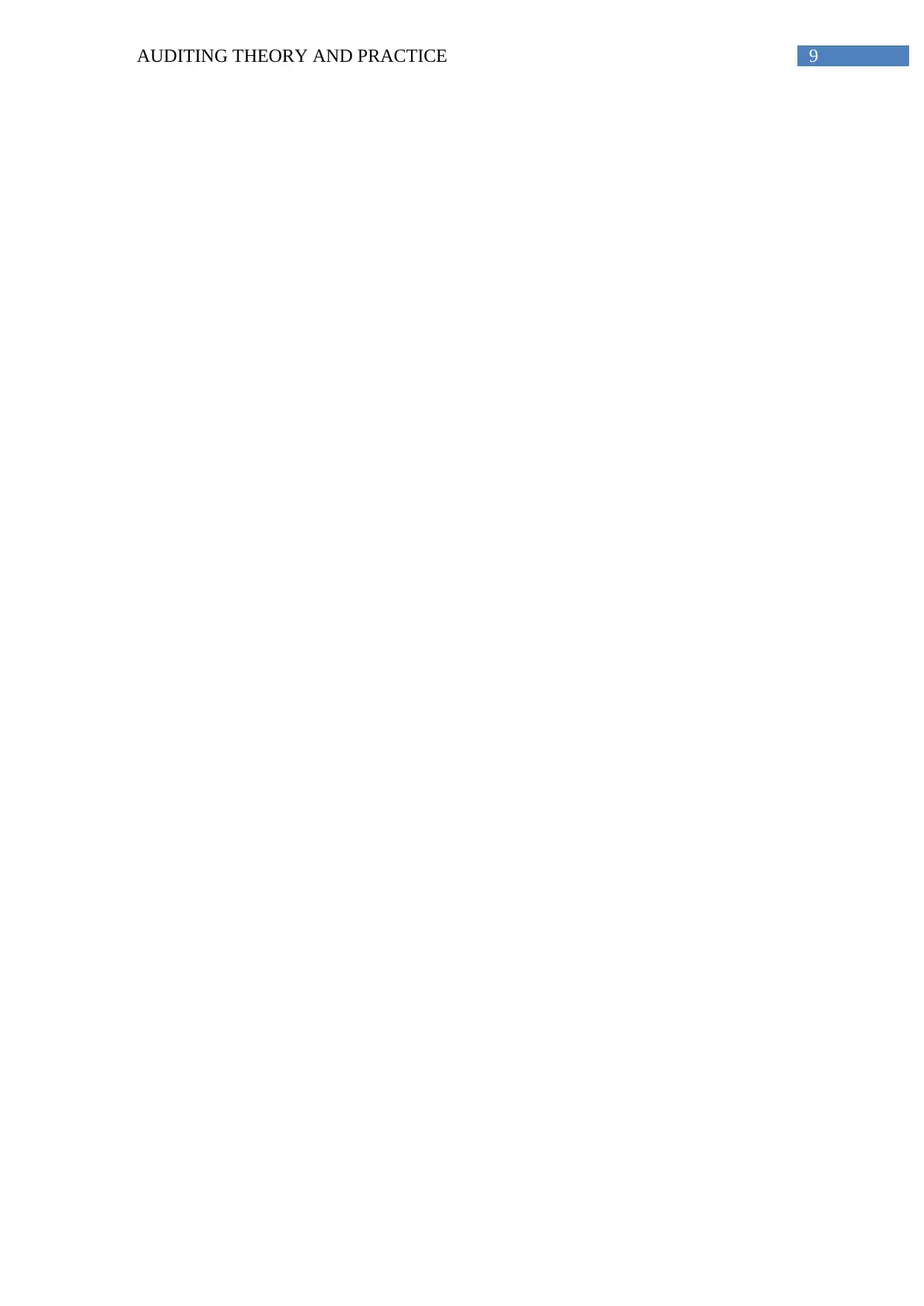
9AUDITING THEORY AND PRACTICE
1 out of 10
Related Documents
Your All-in-One AI-Powered Toolkit for Academic Success.
+13062052269
info@desklib.com
Available 24*7 on WhatsApp / Email
![[object Object]](/_next/static/media/star-bottom.7253800d.svg)
Unlock your academic potential
Copyright © 2020–2025 A2Z Services. All Rights Reserved. Developed and managed by ZUCOL.



